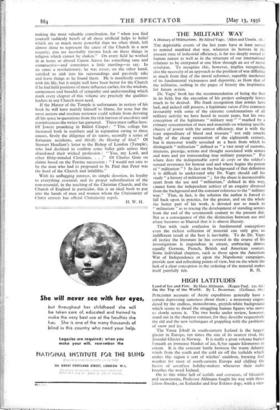HIGH LATITUDES
PUBLISHED accounts of Arctic expeditions generally have a certain depressing sameness about them ; a monotony engen- dered by the endless, monochrome, greyish-white background which seems to dwarf the struggling human figures who move so slowly across it. The two books under review, however, stand out in the sharpest contrast, for they describe respectively the old and the new techniques of grappling with the problems of snow and ice.
The Vatna Jokull in south-eastern Iceland is the largest glacier in Europe, ten times the size of its nearest rival, the Jostedal Glacier in Norway. It is really a great volcano buried eneath an immense blanket of ice, 8,700 square kilometres in extent. It is the constant battle between the warm Atlantic winds from the south and the cold air off the icefields which makes this region a sort of witches' cauldron, brewing foul weather for most of north-eastern Europe and chilling the hearts of countless holiday-makers whenever their radio breathes the word Iceland.
On to this white hell of icefalls and crevasses, of blizzards and snowstorms, Professor Ahlmann fought his way with three fellow-Swedes, an Icelander and fOur Eskimo dogs, with a view
to making the first scientific study of conditions on the glacier, measuring the precipitation, the rate of melting and so forth. In these objects the hardy little expedition succeeded in spite of frostbite and almost unprecedented storms.
The second half of Land of Ice and Fire describes their home- ward journey through the most backward and desolate part of Iceland, the gravelly plains between the glacier and the sea, perpetually traversed by deep, unbridged and icy torrents from Vatna Jdkull and completely flooded when at frequent intervals
a volcanic eruption melts a great mass of the ice. Professor Ahlmarm is to be congratulated on an interesting and well- illustrated description of a very plucky expedition.
The five Scandinavians had to rely solely on themselves and
their dogs, they had to count every krona, and their only com-
munication with the outside world was the primitive telephone line, to which all the farms could listen in. Last year's great Soviet air expedition to the North Pole was on a very different scale. Organised by the Northern Sea Routes Commission and led by its director, Otto Schmidt, it consisted of six aero- planes and forty-four men. It had the advantages of a specially prepared base at Rudolf Land (three-quarters of the way to the Pole), icebreakers, the backing of the Russian Government and the whole resources of the Soviet Union behind it. Wireless played a very important part in keeping the airmen in touch with each other and with weather conditions. Indeed, it is hard to see how without it the gallant explorers could have achieved the brilliant success they did. At least, we gather
it was a brilliant success from the contemporary Press reports and from the panegyrics of Mr. Brontman, the Pravda cor- respondent with the expedition. Yet what are we supposed to make of the recently-published decision of the Council of
People's Commissars after reading Professor Schmidt's report on the work of his department during 1937 ?
" The unpardonable fact exists (says the Council) that nearly half the transport ships and most of the icebreakers of the Northern Sea Routes Administration are hibernating, drifting in ice, and subject to danger of destruction. Bad organisation, complacency, and exaggerated self-opinion have created an atmosphere for the criminal anti-Soviet activity of wreckers."
Is this " complacency and exaggerated self-opinion " intended
as a hit at Mr. Brontman and the rest of those who, accordin to the author of On the Top of the World, carried out their daring exploit with such clockwork precision ? Was the whole thing really a failure, exploited as a success for propaganda purposes Or have these brave men somehow fallen victims to some political intrigue in Moscow ? It is yet another enigma to add to those with which the Soviet authorities have so lavishly















































 Previous page
Previous page